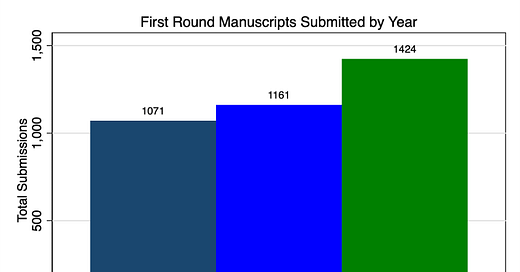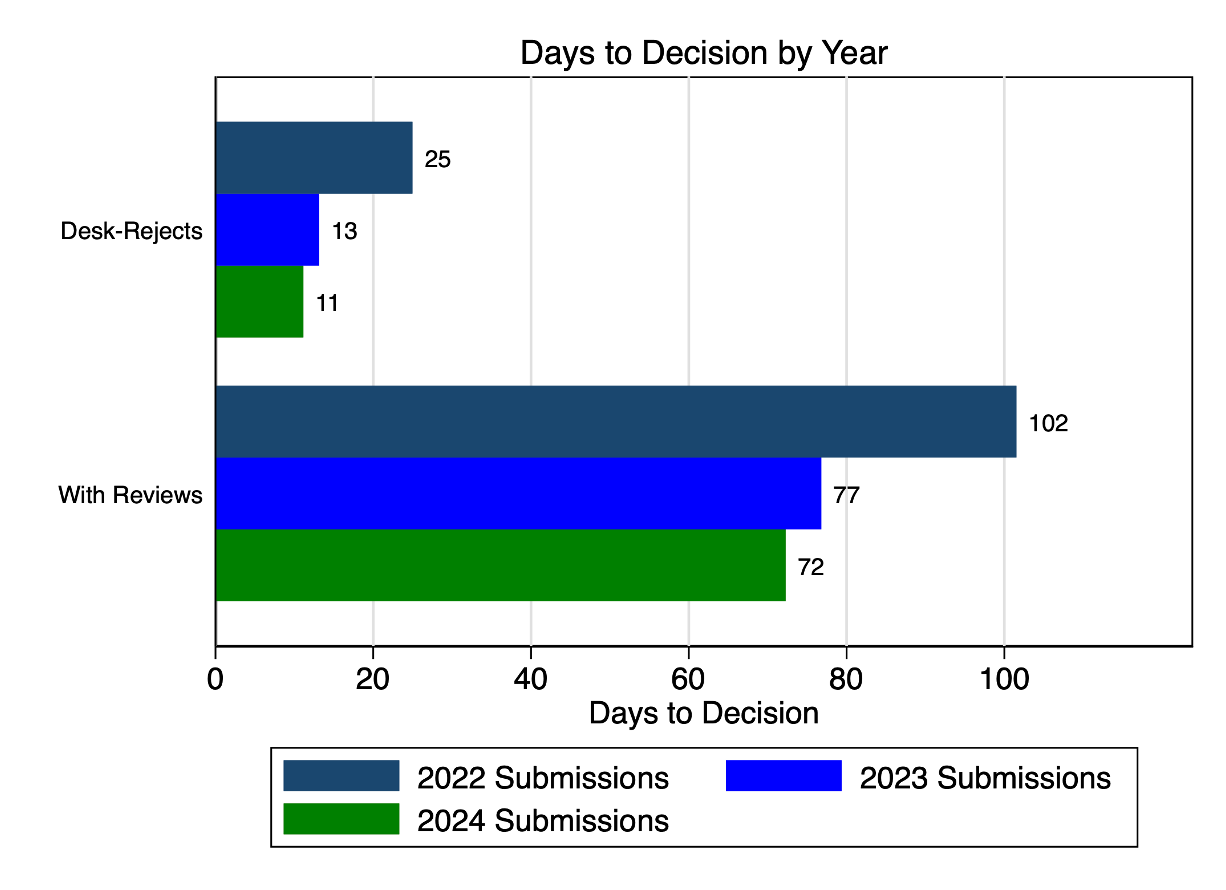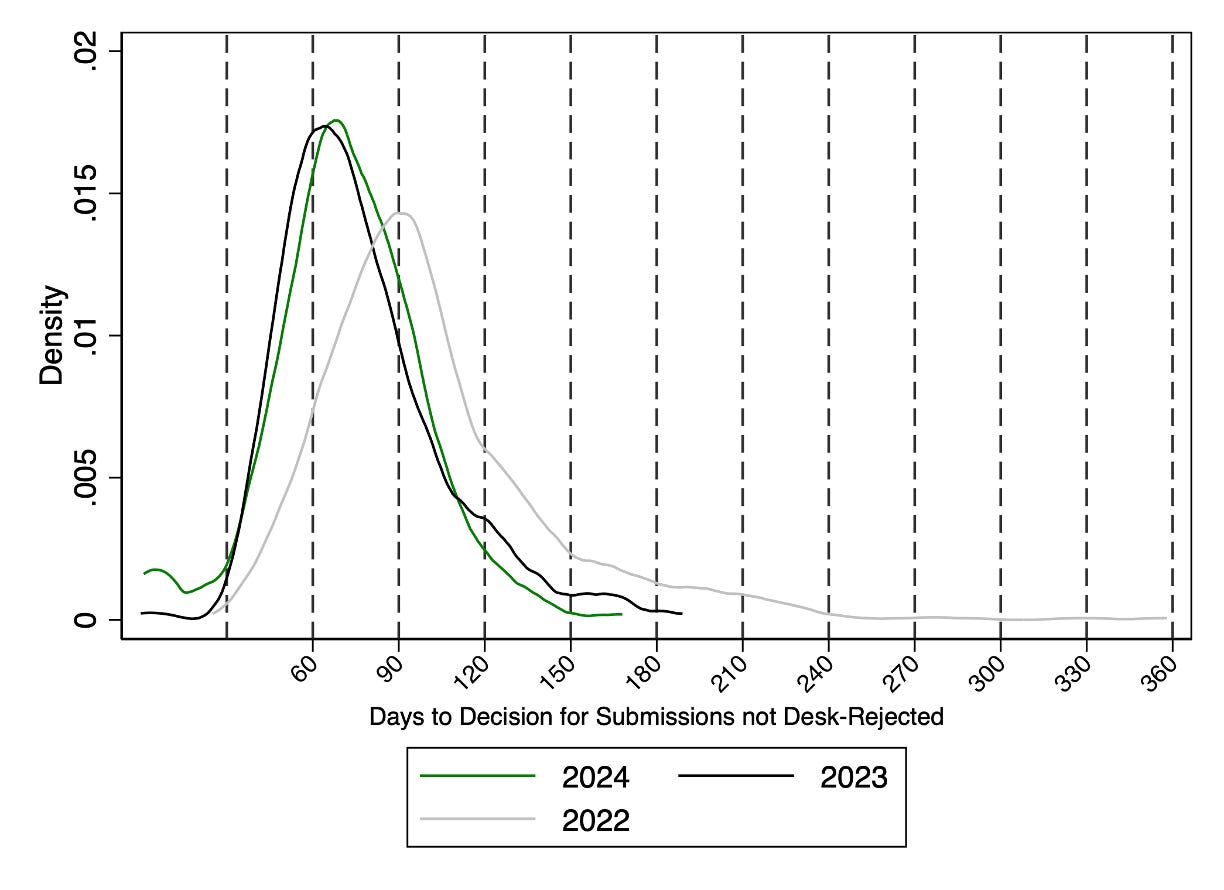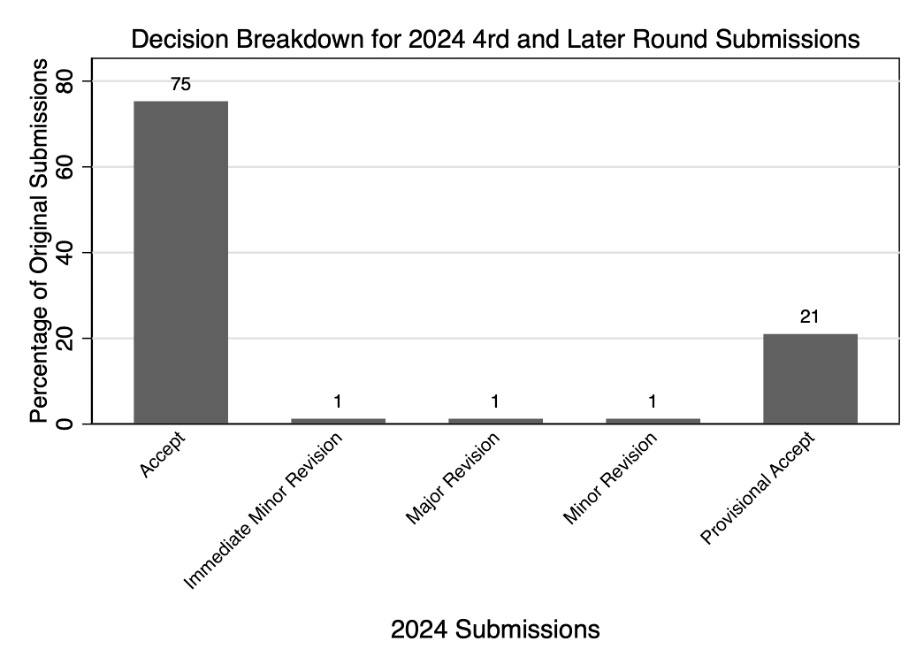The 2024 Organization Science Annual Performance Report
Peach is a very nice color for histograms
In my typical throes of coding ineptitude, it took me longer than expected to produce the 2024 Annual Performance Report, mostly as I debated histogram color schemes and repeatedly forgot how to use “merge” in Stata (yes I’m old). As you’ll see shortly, there’s a lot to be excited about in there, but also room for improvement. Most importantly, we hope to be transparent about what authors should expect and where we are succeeding and failing. I’m opening up comments here in case anyone has any questions or information they’d like to see that’s not here. As always, I’m grateful to our outstanding team of editors, reviewers, and authors for making this happen. It’s hard to believe I’ve started my third year as EIC and that most of you are all still choosing to stay on this journey.
Before we begin, I wanted to note that next Monday is the start of the 2025 Org Science Winter Conference at UCLA. This year the conference will honor Linda Argote, one of the great organizational scholars of our time, co-founder of the winter conference, and editor-in-chief for six years. That’s of course just part of what she’s accomplished and contributed. We’ve got a great program planned, so I’ll look forward to seeing many of you there. For others, stay tuned as we announce the location and dates for the 2026 conference next week. My recommended February location of Svalbard, with the theme of “OrgSci After Dark!”, sadly was not approved by the chair.
I also want to recognize the passing of two giants in the broader management field this week: Richard Nelson and Richard Bettis. Nelson’s work was a pillar of my education at Berkeley, and I’ll never forget how he sat down and had a beer with Stu Graham and me at the 2002 Denver AOM when we were just grad students. Bettis helped implement many important changes at SMJ that we emulate here and gave me my first paper acceptance when it was desperately needed. These are but a few of their contributions. I’m grateful to both.
2024 Performance Report
It's been another outstanding period for the journal as submissions continue to rise, review time stays stable, and we've finally almost cleared out old papers from pre-2023. Our reputation and impact continue to rise to match the quality of papers we’ve always published. And as you all know, this was a team effort involving the editorial board, the ERB, and everyone in the research community that cares about the success of the journal and field. So thank you all for your contributions.
Submissions
First round submissions are up 23% from 2023 with total submissions hitting 1,743. This part of a general growth trend at business journals but we are on the right tail.
Papers in Inventory
As of January 1, we had only one paper in inventory (under review) over 120 days, a major improvement over the last couple of years. Eliminating the right tail on review time is a key journal priority.
Review Times
Our average review times for papers in 2024 remain in the low-to-mid 70s, with desk rejects averaging 11 days. We might be a week or two slower in the first round than AMJ, and our Substack friends at ASQ are a bit faster, but at our scale and scope it would be costly to cut this much. Our focus is on the right tail and on reducing rounds, where we’re also making great progress.
In the spirit of transparency, I like to show the full distribution of review times. As you can see, there’s still room for improvement, but I’m confident we’ll clean up the papers over 120 days (one of which I was responsible) in 2025 . But we are continuing to improve, even over last year.
What’s even more striking is the speed in later rounds, partly because editors don’t repeatedly send them out for review. Note that “Round 0” in the INFORMS system is the initial submission (really Round 1).
Our backlog of accepted papers is down to 4.42 issues, which is the lowest level since at least 2016. What does that mean? It currently takes about 9 months from acceptance to coming out in an issue. We’ll continue to reduce this, since its still too long, but with the full rollout of our “Just Accepted” papers, your paper should be up online within a few days of you uploading the final version.
Decisions and Reviews
And these shorter times are not because we’re rejecting more papers. As you can see, our first-round rejection rate has remained steady, with only 4% of third-round submissions rejected and none after that. Late round rejections are costly for everyone.
The review process simply does not drag on endlessly at Org Science. What happens in Round 3? 71% are fully or provisionally accepted, 19% get minor revisions, and only 7% get another major revision.
Round 4 and beyond? We’re pretty much done and you’ll soon see your paper online.
If there’s one thing to take away from this, it’s that submitting your paper to Organization Science now is not the start of an epic journey. Our current editorial team is fast and committed to minimizing rounds for both reviewers and authors.
We’re still returning three reviews for nearly all papers we send out thanks to our great reviewers and editors. When you review for Organization Science, you also will not be embarking on an epic journey across many rounds. Most papers go out to reviewers only once or twice, and almost never a fourth time.
Impact Factor
Our Impact Factor went back up to 4.9 for 2023 (released in 2024)—counter to trends in our field. We’ll be facing headwinds due to the Clarivate formula change for 2024, but I still anticipate the IF to continue to rise. Impact Factor is never the objective, but it’s a KPI of getting read, as are downloads (up 18% in 2024).
To Summarize. . .
Substack is telling me I’m almost at the email length limit, so I’ll wrap this up. If you aren’t already subscribed, we hope you’ll do so. To summarize, it’s been a great year at Organization Science and we’ll continue to work hard to continually improve. It’s a team effort, so I’m grateful to everyone.
-Lamar
















FYI: I just deleted a comment because it posted a link to a personal grievance about identifiable others that I desk rejected. In the interest of transparency, I will quote the one relevant and substantive opinion of the author. We welcome disagreement and debate. We do not welcome personal grievances with others.
"[A] high impact factor does no say much - you may just be feeding into the - by now - quite problematic mainstream. The field only likes do-good stories and systematically avoids all uncomfortable discussions."
Where is the cat?